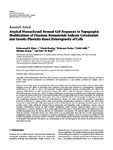Atypical Mesenchymal Stromal Cell Responses to Topographic Modifications of Titanium Biomaterials Indicate Cytoskeletal- and Genetic Plasticity-Based Heterogeneity of Cells
| dc.contributor.author | Khan, MR | |
| dc.contributor.author | Mordan, N | |
| dc.contributor.author | Parkar, M | |
| dc.contributor.author | Hagen, Chris | |
| dc.contributor.author | Donos, N | |
| dc.contributor.author | Brett, PM | |
| dc.date.accessioned | 2019-10-11T11:20:04Z | |
| dc.date.issued | 2019-07-01 | |
| dc.identifier.issn | 1687-9678 | |
| dc.identifier.issn | 1687-9678 | |
| dc.identifier.other | ARTN 5214501 | |
| dc.identifier.uri | http://hdl.handle.net/10026.1/14979 | |
| dc.description.abstract |
<jats:p>Titanium (Ti) is widely used as a biomaterial for endosseous implants due to its relatively inert surface oxide layer that enables implanted devices the ability of assembling tissue reparative components that culminate in osseointegration. Topographic modifications in the form of micro- and nanoscaled structures significantly promote osseointegration and enhance the osteogenic differentiation of adult mesenchymal stromal cells (MSCs). While the biological mechanisms central to the differential responses of tissues and cells to Ti surface modifications remain unknown, adhesion and morphological adaptation are amongst the earliest events at the cell-biomaterial interface that are highly influenced by surface topography and profoundly impact the regulation of stem cell fate determination. This study correlated the effects of Ti topographic modifications on adhesion and morphological adaptation of human MSCs with phenotypic change. The results showed that modified Ti topographies precluded the adhesion of a subset of MSCs while incurring distinct morphological constraints on adherent cells. These effects anomalously corresponded with a differential expression of stem cell pluripotency and Wnt signalling-associated markers on both modified surfaces while additionally differing between hydrophobic and hydrophilic surface modifications—though extent of osteogenic differentiation induced by both modified topographies yielded similarly significant higher levels of cellular mineralisation in contrast to polished Ti. These results suggest that in the absence of deposited proteins and soluble factors, both modified topographies incur the selective adhesion of a subpopulation of progenitors with relatively higher cytoskeletal plasticity. While the presence of deposited proteins and soluble factors does not significantly affect adherence of cells, nanotopographic modifications enhance expression of pluripotency markers in proliferative conditions, which are conversely overridden by both modified topographies in osteogenic inductive conditions. Further deciphering the mechanisms underlying cellular selectivity and Ti topographic responsiveness will improve our understanding of stem cell heterogeneity and advance the potential of MSCs in regenerative medicine.</jats:p> | |
| dc.format.extent | 1-16 | |
| dc.format.medium | Electronic-eCollection | |
| dc.language | en | |
| dc.language.iso | en | |
| dc.publisher | Hindawi | |
| dc.subject | Regenerative Medicine | |
| dc.subject | Stem Cell Research - Nonembryonic - Non-Human | |
| dc.subject | Stem Cell Research - Nonembryonic - Human | |
| dc.subject | Bioengineering | |
| dc.subject | Biotechnology | |
| dc.subject | Stem Cell Research | |
| dc.subject | 1.1 Normal biological development and functioning | |
| dc.title | Atypical Mesenchymal Stromal Cell Responses to Topographic Modifications of Titanium Biomaterials Indicate Cytoskeletal- and Genetic Plasticity-Based Heterogeneity of Cells | |
| dc.type | journal-article | |
| dc.type | Journal Article | |
| plymouth.author-url | https://www.webofscience.com/api/gateway?GWVersion=2&SrcApp=PARTNER_APP&SrcAuth=LinksAMR&KeyUT=WOS:000475652100001&DestLinkType=FullRecord&DestApp=ALL_WOS&UsrCustomerID=11bb513d99f797142bcfeffcc58ea008 | |
| plymouth.volume | 2019 | |
| plymouth.publication-status | Published | |
| plymouth.journal | Stem Cells International | |
| dc.identifier.doi | 10.1155/2019/5214501 | |
| plymouth.organisational-group | /Plymouth | |
| plymouth.organisational-group | /Plymouth/Faculty of Health | |
| plymouth.organisational-group | /Plymouth/Faculty of Health/Peninsula Dental School | |
| plymouth.organisational-group | /Plymouth/REF 2021 Researchers by UoA | |
| plymouth.organisational-group | /Plymouth/REF 2021 Researchers by UoA/UoA03 Allied Health Professions, Dentistry, Nursing and Pharmacy | |
| plymouth.organisational-group | /Plymouth/Research Groups | |
| plymouth.organisational-group | /Plymouth/Research Groups/Institute of Translational and Stratified Medicine (ITSMED) | |
| plymouth.organisational-group | /Plymouth/Research Groups/Institute of Translational and Stratified Medicine (ITSMED)/CBR | |
| plymouth.organisational-group | /Plymouth/Users by role | |
| plymouth.organisational-group | /Plymouth/Users by role/Academics | |
| dc.publisher.place | United States | |
| dcterms.dateAccepted | 2019-05-20 | |
| dc.rights.embargodate | 2019-12-18 | |
| dc.identifier.eissn | 1687-9678 | |
| dc.rights.embargoperiod | Not known | |
| rioxxterms.version | Version of Record | |
| rioxxterms.versionofrecord | 10.1155/2019/5214501 | |
| rioxxterms.licenseref.uri | http://www.rioxx.net/licenses/all-rights-reserved | |
| rioxxterms.licenseref.startdate | 2019-07-01 | |
| rioxxterms.type | Journal Article/Review |


